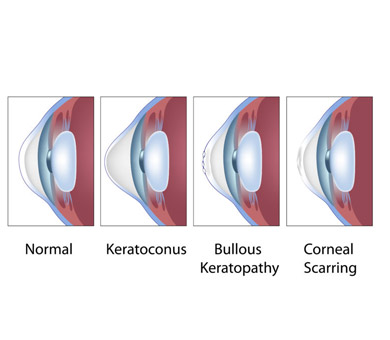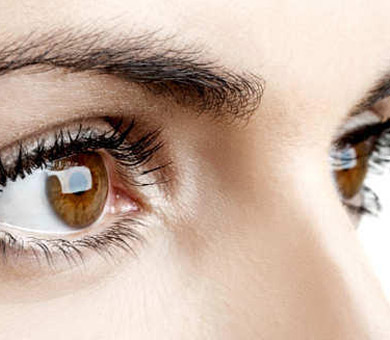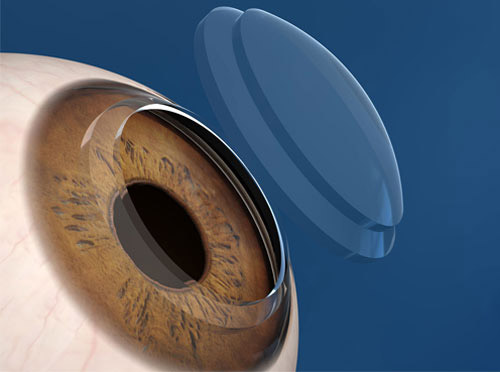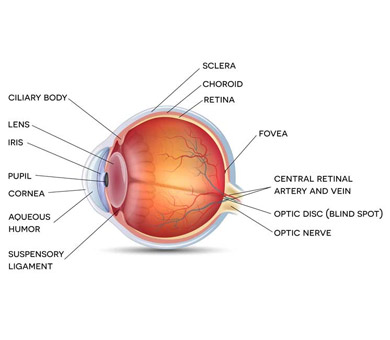What is Corneal Transplant
Corneal TransplantCorneal Transplant
More than 40,000 corneal transplants are performed by ophthalmologists in the United States every year.
What is the cornea?
The cornea is the clear front part of the eye which covers the colored iris and the round pupil. Passing through the cornea, light is focused so we can see. To stay clear, the cornea must stay healthy.
What are the effects of an unhealthy cornea on vision?

What are the effects of an unhealthy cornea on vision?
The cornea may become swollen or scarred if it is damaged. In both cases, its smoothness and clarity may be lost. The scars, swelling or an irregular shape cause the cornea to scatter or distort light, resulting in glare or blurry vision.
What conditions require corneal transplants?
A corneal transplant is needed if:
1- Vision cannot be corrected using other techniques
2- Painful swelling cannot be relieved by medications or special contact lenses
3- Corneal failure following other eye surgery, for example cataract surgery
4- Hereditary corneal failure, such as Fuch's dystrophy cornea
5- Keratoconus, a steep curving of the surface of the cornea
6- Scarring after infections, such as Herpes Simplex and Zoster
7- Scarring after eye injury
8- Rejection after first corneal transplant
9- Complications after LASIK (lamellar transplants)
What happens when you decide to have a corneal transplant?

What happens when you decide to have a corneal transplant?
Before surgery, when you and Dr Jaoude decide that you need a corneal transplant, your name will be put on a list at the local eye bank. Normally, the wait is short. The eye bank approves a cornea for transplant by testing the human donor for the viruses that cause hepatitis & AIDS and checking the cornea carefully for clarity. Dr Jaoude may request a physical examination and other special tests. If you usually take medications, ask Dr Jaoude or one of our staff if you should continue taking them. You need to stop any medicine that affects your coagulation and causes your blood to be thinner like Coumadin, Aspirin, Vitamin E, Advil, Ibuprofen, Naproxen, Garlic Pills… if you are on any such medications, discuss this matter with Dr Jaoude.
The Day of Surgery
Surgery is often done on an outpatient basis. You will be asked not to eat or drink anything after midnight the night of the surgery. Do not have breakfast nor drink water or coffee or smoke the morning of the surgery. Once you arrive to the surgery center, you will be given eye drops and sometimes medications to help you relax.
The Operation
The eyelids are gently opened using a special tool. Looking through a surgical microscope,
Dr Jaoude measures your eye for the size of the cornea.Then he carefully removes the diseased or injured cornea from your eye.
Any necessary additional work within the eye, such as removal of a cataract, is also completed during the same surgery.
Next, the clear donor cornea is sewn into place. When the operation is over, Dr Jaoude will place a patch and a shield over your eye for protection.
After surgery and a short stay in the recovery area, you can return home; however, you should plan to have someone drive you home. An examination at Dr Jaoude's office will be scheduled for the next day. You must:
1- Use the eye drops as prescribed
2- Not rub or press on your eye
3- Use over-the-counter pain medicine if necessary
4- Continue normal daily activities except exercise
5- Ask Dr Jaoude when you can resume driving
6- Wear eyeglasses or an eye shield as advised by Dr Jaoude. Depending upon the health of your eye and rate of healing, Dr Jaoude will decide when to remove the stitches. Normally, stitches are not removed before several months, at least.
What can I expect after surgery?

What can I expect after surgery?
As mentioned earlier, corneal transplants are done on an outpatient basis. Although the procedure itself takes 45 minutes to 75 minutes depending on the complexity of the situation, you should expect to spend the whole morning at the surgery center. When you leave the hospital you will be wearing a patch and a shield, which will be removed the next day on your follow up visit at Dr Jaoude's office. After that, you will need to wear dark glasses during the day and a protective shield at night while sleeping. Your vision will be blurry for around 3 - 6 months. For the first 6 weeks, you must abstain from heavy exercise and/or lifting of heavy objects, but otherwise you can live a normal life. Most people return to work 3-7 days after their surgery depending on their type of work. After 3 months, you may have your sutures removed or Dr Jaoude may elect to keep your sutures for a longer period of time. You will not feel these sutures in the eye nor will you see them. Around 3 to 6 months following surgery and depending on your healing, you will be fitted with glasses or contact lenses.
Can I get rid of contact lenses or glasses after surgery?
Yes it is possible to be free of contact lenses or glasses after transplant surgery. However, this may require additional procedures such as astigmatic keratotomy or LASIK. The fees for these procedures are not included in the cost of the corneal transplant and may not be covered by insurance, although under certain circumstances they may be covered. You can discuss these situations with Dr Jaoude. Most patients are left with a certain amount of nearsightedness and astigmatism, after all sutures are removed. This can be corrected with soft or rigid contact lenses or glasses. Large astigmatism can be corrected with astigmatic keratotomy to bring the patient to less than 4D of astigmatism. Patients with less than 4D of astigmatism and less than 8D of myopia may then have their vision corrected with LASIK if they wish to do so and if they are good candidates. (Please check the link on LASIK for what makes you a good candidate) We have many patients who have successfully undergone these procedures and some of them would be happy to talk to you about their experiences.
Who is best qualified to do a corneal transplant?
The most qualified person to do a corneal transplant is an ophthalmologist fellowship trained in corneal transplant surgery. Dr Jaoude is the only Fellowship trained Corneal Transplant surgeon in the mid and southern Delaware area. Dr Jaoude trained in corneal transplant surgery at Emory University in Atlanta, Georgia.
What are the Symptoms of a CATARACT?

What are the possible complications?
Corneal transplants are rejected 5% to 30% of the time. The rejected cornea becomes cloudy and vision deteriorates, however most of these rejections could be controlled using eye drops, and if treated promptly, can be stopped with minimal injury. Warning signs of rejection are:
1- Persistent discomfort in the eye.
2- Light sensitivity.
3- Redness.
4- Change in vision.
If you encounter any of these symptoms, you should report to Dr Jaoude immediately.Other possible complications include:
1- Infection
2- Bleeding
3- Retinal swelling or detachment
4- Glaucoma
All of these complications can be treated.
If rejection occurs, a corneal transplant can be repeated, usually with good results, but the overall rejection rates for repeated transplants are higher than for the first time. If the transplanted cornea has irregular curvature (astigmatism), this may slow down the return of clear vision, but this can also be treated. Vision may continue to improve up to a year after surgery.
Even if the surgery is successful, other eye conditions, such as macular degeneration (aging of the retina), glaucoma or diabetic damage may limit vision after surgery. Even with such problems, corneal transplantation may still be worthwhile. A successful corneal transplant therefore requires care and attention on part of both patient and physician. Since no other surgery has so much to offer when the cornea is deeply scarred or swollen, the vast majority of people who undergo corneal transplants are satisfied with their improved vision. Of course, corneal transplant surgery would not be possible without the hundreds of thousands of generous donors who have donated corneal tissue so that others may see.